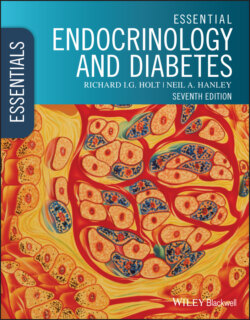Читать книгу Essential Endocrinology and Diabetes - Richard I. G. Holt - Страница 63
Insulin signalling pathways
ОглавлениеThe dimerized insulin receptor comprises two α‐ and two β‐subunits linked by a series of disulphide bridges (Figure 3.6; Chapter 11). When insulin binds, auto‐phosphorylation occurs on the cytosolic domains of the β‐subunit. The activated receptor then phosphorylates two key intermediaries, insulin receptor substrate (IRS) ‐1 or ‐2, which are thought to be essential for almost all the biological actions of insulin. IRS1 has many potential tyrosine phosphorylation sites, at least eight of which are phosphorylated by the activated insulin receptor.
Multiple phosphorylation of IRS‐1 or ‐2 leads to the docking of several proteins with SH2 domains, and the activation of divergent intracellular signalling. For example, docking of phosphatidylinositol‐3‐kinase (PI3‐kinase) leads to deployment of the glucose transporter (GLUT) family members. For instance, in adipose tissue and muscle, GLUT‐4 translocates from intracellular vesicles to the cell membrane, to facilitate glucose uptake into the cell. The mitogenic effects of insulin are mediated via a different intracellular pathway. Activated IRS1 docks with the SH2/SH3 domains of the type 2 growth factor receptor‐bound (Grb2) protein. This adaptor protein links IRS1 to the son of sevenless (SoS) protein and, ultimately, to activation of the mitogen‐activated protein kinase (MAPK) pathway, leading to expression of a gene network that promotes mitosis and growth.
Figure 3.5 Intracellular signalling via phosphorylation. (a) Amino acids serine, threonine and tyrosine carry polar hydroxyl (OH) groups that can be phosphorylated. Over 99% of all protein phosphorylation occurs on serine and threonine residues. Phosphorylation of tyrosine, the only amino acid with a phenolic ring, generates particularly distinctive intracellular signalling pathways. (b) Protein 1 is inactive until its hydroxyl group is phosphorylated by the action of a kinase enzyme. This induces a conformational change and an activated phosphorylated protein. Energy for the transfer of the phosphate group comes from the hydrolysis of ATP to ADP. The reverse reaction, from active to inactive states, is catalyzed by a phosphatase and releases inorganic phosphate (Pi) for reincorporation back into ATP. (c) The initiation of a signalling cascade. Activated phosphorylated protein 1 itself acts as a kinase and catalyzes the phosphorylation of protein 2. Amino acid specificity means that serine/threonine kinases usually show no activity with tyrosine residues and tyrosine kinases do not normally phosphorylate serine or threonine residues.
Defects in the insulin signalling pathway can result in resistance to insulin action either as rare monogenic syndromes (Box 3.4) or as a major contributor to type 2 diabetes (Chapters 11 and 13).
Figure 3.6 The insulin receptor and a simplified view of its signalling pathways. The number of insulin receptors on target cells varies, commonly from 100 to 200,000, with adipocytes and hepatocytes expressing the highest numbers. Not all insulin‐signalling pathways are shown, e.g. type 2 growth factor receptor‐bound protein (Grb2) can be stimulated independently of insulin receptor substrate 1 (IRS1). MAPK, mitogen‐activated protein kinase; PI3 kinase, phosphatidylinositol‐3‐kinase; SoS, son of sevenless protein; I, insulin.
